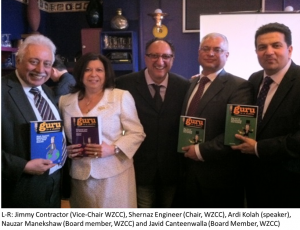In my 20-year plus career within journalism, public relations, marketing and social media I’ve been very fortunate to have worked with some of the most successful global organisations in the world including Andersen Consulting (Accenture), Disney, BBC, The Scout Association, Shell, Ferrari, the International Cricket Council and the Defence Academy of the United Kingdom.
Very often it’s been my job to train chief executives on how best to put across their messages to audiences ranging from several hundred employees and millions of TV viewers.
Whilst all of these communication skills are very important – what we aren’t taught either at school or indeed when we work within our respective professions is how to actively listen.
 And this was the theme of my talk, based on the research I did for my latest book, The Art of Influencing and Selling.
And this was the theme of my talk, based on the research I did for my latest book, The Art of Influencing and Selling.
The event was organised by the World Zarathushti Chamber of Commerce (WZCC) and sponsored by Café Spice Namaste and Godrej that took place on Monday, 1 July.
Let me start by asking you a question.
When was the last time you attended a seminar or workshop which taught you the skills of active listening?
As marketers we seem to be stuck in what I call ‘transmit mode’ rather than also using our ‘receive mode’. In fact, social media dictates that we use listening to speaking in the ratio of 2:1 and this mirrors the fact that we have two ears and one mouth!
So the next question is, what does ‘active listening’ actually look like?
The starting point may surprise you.
I would suggest, given that we are talking about listening from a marketing perspective, to focus on the outcome you desire from the conversation – and work backwards from there. If you programme yourself to think about a positive outcome, you’re dramatically increasing your chances of that outcome happening.
But you’ve got to actively listen!
For example, if your desired outcome is closing a sale with a potential customer with everybody smiling, shaking hands leaving the meeting in the glow that they’ve got a great deal – then focus on that outcome.
Your unconscious mind doesn’t distinguish between what’s imagined and what’s real; so the more effort you put into envisaging a positive outcome, the more your mind may believe that is what’s happening and the more it will enable you to act as though that is what you’re obtaining.
The reverse is true as well.
If you’re not prepared to make the effort to listen, then don’t expect a positive outcome from the meeting.
Reflective listening improves the other person’s attitude towards you and increases their willingness to concede to your point of view.
During the ‘exploring stage’ of the conversation, where your ability to listen for longer is paramount, start to make a mental note about what makes the other person excited or anxious, annoyed, impatient or animated.
Understand how they are prioritising the information they are sharing with you, and listen to the tone of their voice. For example, when do they raise their voice and when do they speak more quickly? Why do they speak more softly or deliberately when talking about other points?
And when they pause, don’t feel the need to fill the void.
Allow them that time to reflect and think about what they want to say next. The silence is golden, so don’t destroy the hard work you’ve put into ‘active listening’ by jumping in. It’s not necessary unless of course they are inviting comment back from you. And even then, pause for thought. Take a breadth and take your time.
Finally, listen with your eyes if you are face to face with the person you’re having the meeting with.
Remember, we are constantly communicating and listening using non-verbal communication – in fact, 55% of all face-to-face communication is about body language and eye contact, 38% is the pitch, speed, volume and tone of voice and just 7% of communication is about the words that are used!
So if you concentrate just on the words being said by the other person, you’re not actively listening!
 Some of the world’s best communicators, such as Sir Richard Branson, tend to have strong body language: a commanding presence that reflects confidence, competence, and charisma. So it’s important that you transmit this to the other person too.
Some of the world’s best communicators, such as Sir Richard Branson, tend to have strong body language: a commanding presence that reflects confidence, competence, and charisma. So it’s important that you transmit this to the other person too.
So here’s a quick summary of the points to remember next time you need to exercise those active listening skills:
Ask: Start by simply expressing an interest in the other person’s point of view. And don’t forget to look interested!
Mirror & Match: Create empathy by reading the body language and matching this. This helps to keep the conversation in the other person’s comfort zone. Keep this natural!
Paraphrase: As the other person begins to share their story with you, restate what you’ve heard to show that you understand, but also it’s safe for that person to share with you what they’re thinking.
Prime: To keep the conversation flowing, use open questions and make observations about what they may be thinking or feeling. It’s OK to consider the emotional side of an issue, problem, challenge, topic of discussion as well the rational side of it.
Share: Provide an amount of input that is about the same in terms of volume that the other person is also sharing – in other words, don’t overwhelm the person whose turn it is to listen to you!
Don’t forget to agree where you find consensus; build where you want to influence the direction of the conversation and compare different points of view where there is a divergence of opinion but acknowledge this in a non-threatening and positive way.
Get this cracked and others will be more inclined to listen to you!














Recent Comments